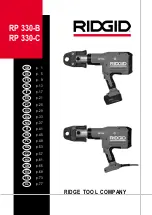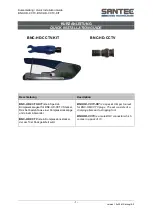
16
en
Hold the power tool by the insulated gripping surfaces
when performing operations where the application tool
could contact hidden wiring or its own power supply
cable.
Contact with a “live” wire will also make
exposed metal parts of the tool “live” and shock the
operator.
Safety instructions when using long drill bits.
Never operate at higher speed than the maximum speed
rating of the drill bit.
At higher speeds, the bit is likely
to bend if allowed to rotate freely without contacting
the workpiece, resulting in personal injury.
Always start drilling at low speed and with the bit tip in
contact with the workpiece.
At higher speeds, the bit is
likely to bend if allowed to rotate freely without con-
tacting the workpiece, resulting in personal injury.
Apply pressure only in direct line with the bit and do not
apply excessive pressure.
Bits can bend causing break-
age or loss of control, resulting in personal injury.
Special safety instructions.
Beware of any concealed electric cables, gas or water
conduits.
Check the working area before commencing
work, e. g. with a metal detector.
Secure the work piece firmly.
A work piece that is
gripped tightly in a clamping device or vice, is more
secure than if held by hand.
Hold the power tool firmly.
High reaction torque can
briefly occur.
Do not direct the power tool against yourself, other per-
sons or animals.
Danger of injury from sharp or hot
application tools.
Do not rivet or screw any name-plates or signs onto the
power tool.
If the insulation is damaged, protection
against an electric shock will be ineffective. Adhesive
labels are recommended.
Do not use accessories which are not specifically
designed and recommended by the power tool manu-
facturer.
Safe operation is not ensured merely because
an accessory fits your power tool.
Wear personal protective equipment. Depending on
application, use face shield, safety goggles or safety
glasses. Where appropriate, wear dust mask, hearing
protectors, gloves and workshop apron capable of stop-
ping small abrasive or workpiece fragments.
The eye
protection must be capable of stopping flying debris
generated by various operations. The dust mask or res-
pirator must be capable of filtrating particles generated
by your operation. Prolonged exposure to high inten-
sity noise may cause hearing loss.
Dress properly. Do not wear loose clothing or jewellery.
Keep your hair, clothing and gloves away from moving
parts.
Loose clothes, jewellery or long hair can be
caught in moving parts.
When working overhead, beware of falling objects,
such as chips.
To prevent injuries, always keep your hands, clothing,
etc. away from rotating swarf.
The swarf can cause inju-
ries.
Do not attempt to remove the cutting tool if it still turns.
This can lead to serious injuries.
Clean the ventilation openings on the power tool at reg-
ular intervals using non-metal tools.
The blower of the
motor draws dust into the housing. An excessive accu-
mulation of metallic dust can cause an electrical hazard.
Do not work with materials containing magnesium.
Danger of fire.
Do not work with CFRP (carbon-fiber-reinforced poly-
mer) and materials containing asbestos.
These materi-
als are considered carcinogenic.
Before putting into operation, check the mains connec-
tion and the mains plug for damage.
Recommendation: The tool should always be supplied
with power via a residual current device (RCD) with a
rated current of 30 mA or less.
Hand/arm vibrations
The vibration emission level given in this information
sheet has been measured in accordance with a stand-
ardised test given in EN 62841 and may be used to
compare one tool with another. It may be used for a
preliminary assessment of exposure.
The declared vibration emission level represents the
main applications of the tool. However, if the tool is
used for different applications, with different accesso-
ries or poorly maintained, the vibration emission may
differ. This may significantly increase the exposure level
over the total working period.
An estimation of the level of exposure to vibration
should also take into account the times when the tool
is switched off or when it is running but not actually
doing the job. This may significantly reduce the expo-
sure level over the total working period.
Identify additional safety measures to protect the oper-
ator from the effects of vibration such as: maintain the
tool and the accessories, keep the hands warm, organi-
sation of work patterns.
Handling hazardous dusts
For work procedures with this power tool where
material is removed, dusts develop that can be hazard-
ous to one’s health.
Contact with or inhaling some dust types, e. g. asbestos
and asbestos-containing materials, lead-containing coat-
ings, metal, some wood types, minerals, silicate parti-
cles from materials containing stone, paint solvents,
wood preservatives, antifouling paints for vessels, can
trigger allergic reactions to the operator or bystanders
and/or lead to respiratory infections, cancer, birth
defects or other reproductive harm. The risk from
inhaling dusts depends on the exposition. Use dust
extraction matched appropriately for the developing
dust, as well as personal protective equipment and pro-
vide for good ventilation of the workplace. Leave the
processing of asbestos-containing materials to special-
ists.
Summary of Contents for BOP6
Page 1: ...BOP6 7 205 BOP10 7 205 BOP10 2 7 205 BOP13 2 7 205 WBP10 7 205 ...
Page 3: ...3 9 8 7 7 8 4 5 6 ...
Page 4: ...4 1 2 3 1 4 3 2 5 BOP6 BOP10 BOP10 2 BOP13 2 ...
Page 5: ...5 1 1 35 Nm M 8 1 1 2 BOP6 BOP10 BOP10 2 BOP13 2 BOP6 BOP10 BOP10 2 BOP13 2 WBP10 ...
Page 6: ...6 3 1 2 4 1 2 3 4 5 1 2 WBP10 WBP10 BOP6 BOP10 BOP10 2 BOP13 2 ...
Page 7: ...7 BOP10 2 BOP13 2 ...
Page 8: ...8 1 2 1 2 4 BOP6 BOP10 BOP10 2 BOP13 2 3 ...
















































